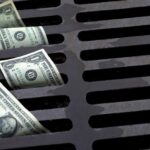
In a decisive move indicating the continuation of its “maximum pressure” campaign, the U.S. Department of the Treasury announced sanctions against 22 companies across Hong Kong, the United Arab Emirates, and Turkey. These entities were designated for facilitating the sale of Iranian oil-key revenue that reportedly funds Iran’s Islamic Revolutionary Guard Corps–Quds Force (IRGC‑QF), previously identified by Washington as a foreign terrorist organization.
The Sanctions’ Target
The Treasury’s Office of Foreign Assets Control (OFAC) added 22 foreign-registered firms to its Specially Designated Nationals (SDN) list. The firm roster spans across multiple jurisdictions, reflecting Iran’s expansive global oil-evading apparatus.
These companies are impeached of aiding Iran in circumventing longstanding U.S. sanctions that prohibit Iranian crude exports. Specifically, they allegedly utilized clandestine shell structures and offshore banking facilities to funnel hundreds of millions of dollars from oil proceeds into the coffers of the IRGC‑QF. That money is believed to underpin Iran’s nuclear and ballistic missile programs, as well as its support for various armed militant groups throughout the Middle East.
This latest round of designations aligns with the U.S.’s broader sanctions strategy. Earlier this year, OFAC unmasked a sprawling “shadow banking” network that laundered billions for Iran’s military via front companies and money exchangers in the UAE and Hong Kong. That earlier action targeted over 30 individuals and firms, including two closely tied to Iran’s National Tanker Company, a state-linked oil transport entity.
Now, with the 22 new companies, Washington again aims to strangle the lifelines enabling Tehran to trade oil internationally and accumulate revenue to advance nuclear, missile, and proxy operations. To navigate to the official U.S. Treasury website, click here.
Major Escalations in U.S. Sanctions Strategy Against Iran: an Overview
Building on its ongoing “maximum pressure” approach, the United States has incremented its sanctions arsenal significantly in 2025 to further constrain Iran’s capacity to finance weapons development, proxy militancy, and illegal oil trade. This year has seen multiple waves of targeted actions that stretch beyond oil exports, capturing a broader ecosystem of maritime logistics, front companies, drone technologies, and clandestine financial networks.
One of the most impactful moves came in July 2025, when the U.S. Treasury sanctioned a high-profile shipping and smuggling network closely linked to Ali Shamkhani, a former Iranian defense official. This network had allegedly initiated extensive covert oil sales, with shipments routed primarily to China using disguised vessels, shell companies, and fabricated documentation. Over 50 individuals, firms, and ships were blacklisted, marking one of the largest single-day sanctions announcements in recent years. The aim is to interrupt billions in annual revenue flowing directly into Iran’s defense apparatus. To navigate to the official U.S. Treasury webiste, click here.
Following this, the U.S. further clamped down on Iran’s military technology capabilities by targeting suppliers involved in its drone manufacturing sector. In late July 2025, OFAC named several entities participating in the development and export of Iranian unmanned aerial vehicles (UAVs), which have been used by regional proxies in destabilizing operations. By sanctioning the logistical chain that supports drone assembly and parts acquisition, the U.S. is aspiring to cut off Tehran’s access to critical military hardware.
A key dimension of the sanctions strategy has been financial. In June 2025, a major shadow banking operation came to light. Over 40 individuals and firms operating across the UAE, Hong Kong, and Iran were exposed for laundering oil revenue through a web of unlicensed money exchangers, front companies, and falsified trade deals. This parallel financial system allegedly enabled Tehran to bypass restrictions and quietly repatriate profits into military budgets.
Even Iran’s liquefied petroleum gas (LPG) exports have come under scrutiny. In April 2025, authorities sanctioned companies and intermediaries involved in disguising the origin of Iranian LPG for sale on global markets. These funds, like oil revenues, were believed to support the Quds Force and other paramilitary operations.
Earlier in February, another major disruption targeted Sepehr Energy and associated vessels involved in unauthorized Iranian crude exports. The U.S. accused them of selling millions of barrels under deceptive registries and shipping arrangements, enabling Iran to secretively maintain its oil trade despite formal prohibitions.
The Need of these Sanctions
- Lack of Diplomatic Breakthroughs
- Preventing Military Funding
- Creating Deterrence
- Tactical Intelligence Gaps
Impacts and Larger Ramifications
On Iran’s Revenue Stream and Domestic Economy
While this round of actions may not significantly curb output immediately, it threatens the revenue auctions underpinning Iran’s military campaigns. An accretive choke could drain hundreds of millions from the IRGC-QF’s hand, reducing funds allocated to its regional involvement, missile development, and nuclear enrichment efforts.
On Global Financial Pathways
Cutting off exchange houses, shadow banks, and offshore vehicles configures legitimate banks – European, Asian, and Middle Eastern, to hesitate before handling Iran-linked transactions. Increased due diligence and compliance costs may ripple into broader finance networks.
On Regional Proxies and Proxy Conflicts
The IRGC-QF channels huge funding to militant groups like Hezbollah, Hamas, and Shia militias in Syria and Yemen. Disrupting oil revenues jeopardizes the cash needed for weapons, logistics, salaries, and broader militant operations.
On Diplomatic Outreach
Critics argue that the sanctions strategy deepens hostility at a time when diplomacy could resurface, especially as Iran plans new nuclear negotiations. Tehran, however, shows little sign of substantive policy shifts, and U.S. authorities emphasize that pressure alone underpins any future, more constructive engagement.
The Feasibility of the Sanctions
For these sanctions to significantly disrupt funding, several conditions must hold:
- Financial Vigilance
- Target Expansion
- Diplomatic Channels
- Tech and Trade Evasion
The U.S. reaffirms its long-term sanctions strategy aimed at curbing Iran’s financial lifelines. Systematic targeting of front companies, banking intermediaries, and maritime infrastructure seeks to undercut the IRGC-QF’s global funding and operational capacity.
Taken together, these actions reveal a broadened enforcement framework that targets Iran’s revenue chains at multiple levels—logistics, technology, financing, and global trade. The sanctions are not only meant to stifle military spending but also to increase the operational risk for foreign entities considering business with Iranian-linked firms.
The sustained breadth and intensity of these measures underscore Washington’s strategic goal: to dismantle Iran’s overseas support structures, prevent weapons proliferation, and increase the cost of defiance through financial isolation and regulatory pressure.
Ultimately, whether this “maximum pressure” campaign turns the tide depends on continuous enforcement, geopolitical contortions, and Tehran’s willingness or inability to withstand the squeeze without provoking further expansion.



